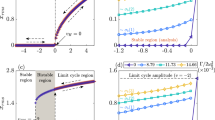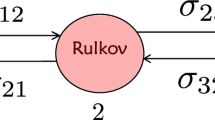Abstract
The stochastic firing patterns are simulated near saddle-node bifurcation on an invariant cycle corresponding to type I excitability in stochastic Morris–Lecar model. In absence of external periodic signal, the stochastic firing manifests continuous distribution in ISI histogram (ISIH), whose amplitude at first increases sharply and then decreases exponentially. In presence of the external periodic signal, stochastic firing patterns appear as two cases of integer multiple firing with multiple discrete peaks in ISIH. One manifests perfect exponential decay in all peaks and the other imperfect exponential decay except a lower first peak. These stochastic firing patterns simulated with or without external periodic signal can be demonstrated in the experiments on rat hippocampal CA1 pyramidal neurons. The exponential decay laws in the multiple peaks are also acquired using probability analysis method. The perfect decay law is determined by the independent characteristic within the firing while the imperfect decay law is from the inhibitory effect. In addition, the stochastic firing patterns corresponding to type I excitability are compared to those of type II excitability. The results not only reveal the dynamics of stochastic firing patterns with or without external signal corresponding to type I excitability, but also provide practical indicators to availably identify type I excitability.









Similar content being viewed by others
References
Bogaard A, Parent J, Zochowski M, Booth V (2009) Interaction of cellular and network mechanisms in spatiotemporal pattern formation in neuronal networks. J Neurosci 29:1677–1687
Braun HA, Wissing H, Schäfer K (1994) Oscillation and noise determine signal transduction in shark multimodal sensory cells. Nature 367:270–273
Chacron MJ, Longtin A, St-Hilaire M, Maler L (2000) Suprathreshold stochastic resonance firing dynamics with memory in P-type electroreceptors. Phys Rev Lett 85:1576–1579
Chialvo DR, Apkarian AV (1993) Modulated noisy biological dynamics: three examples. J Stat Phys 70:375–391
Ermentrout GB (1996) Type I membranes, phase resetting curves, and synchrony. Neural Comput 8:979–1001
Ermentrout GB, Galán RF, Urban NN (2008) Reliability, synchrony and noise. Trends Neurosci 31(8):428–434
Galán RF, Ermentrout GB, Urban NN (2005) Efficient estimation of phase-resetting curves in real neurons and its significance for neural-network modeling. Phys Rev Lett 94(15):158101
Galán RF, Ermentrout GB, Urban NN (2007) Reliability and stochastic synchronization in type I vs type II neural oscillators. Neurocomputing 70:2102–2106
Gammaitoni L, Hanggi P, Jung P, Marchesoni F (1998) Stochastic resonance. Rev Mod Phys 70:223–287
Gerstein GL, Kiang NY-S (1960) An approach to the quantitative analysis of electrophysiological data from single neurons. Biophys J 1:15–28
Gong PL, Xu JX, Hu SJ, Long KP (2002) Chaotic interspike intervals histogram with multipeaked in neurons. Int J Bifurcation Chaos 12:319–328
Gutkin BS, Ermentrout GB (1998) Dynamics of membrane excitability determine inter-spike interval variability: a link between spike generation mechanisms and cortical spike train statistics. Neural Comput 10:1047–1065
Gutkin BS, Ermentrout GB, Reyes A (2005) Phase response curves determine the responses of neurons to transient inputs. J Neurophysiol 94(2):1623–1635
Gu HG, Ren W, Lu QS, Wu SG, Yang MH, Chen WJ (2001) Integer multiple spiking in neural pacemakers without external periodic stimulation. Phys Lett A 285:63–68
Gu HG, Jia B, Lu QS (2011a) Exponential decay characteristics of the integer multiple neural firing patterns. Cogn Neurodyn 5:87–101
Gu HG, Zhang HM, Wei CL, Yang MH, Liu ZQ, Ren W (2011b) Coherence resonance induced stochastic neural firing at a saddle-node bifurcation. Int J Mod Phys B 25:3977–3986
Hodgkin AL (1948) The local electric changes associated with repetitive action in a non-medullated axon. J Physiol 107:165–181
Izhikevich EM (2000) Neural excitability, spiking and bursting. Int J Bifurcation Chaos 10:1171–1266
Izhikevich EM (2007) Dynamical systems in neuroscience: the geometry of excitability and bursting. The MIT Press, Cambridge, p 215
Jia B, Gu HG, Li YY (2011) Coherence resonance induced neuronal firing near a saddle node and homoclinic bifurcation corresponding to type I excitability. Chin Phys Lett 28(9):090507
Liu YH, Yang J, Hu SJ (2008) Transition between two excitabilities in mesencephalic V neurons. J Comput Neurosci 24(1):95–104
Liu ZQ, Zhang HM, Li YY, Hua CC, Gu HG, Ren W (2010) Multiple spatial coherence resonance induced by stochastic signal in neuronal networks near a saddle-node bifurcation. Phys A 389:2642–2653
Longtin A, Bulsara A, Moss F (1991) Time interval sequences in bistable system and the noise-induced transmission of information by sensory neurons. Phys Rev Lett 67:656–659
Longtin A, Bulsara A, Pierson D, Moss F (1994) Bistability and the dynamics of periodically forced sensory neurons. Biol Cybern 70:569–578
Mannella R, Palleschi V (1990) Fast and precise algorithm for compute simulation of stochastic differential equations. Phys Rev A 40:3381–3386
Morris C, Lecar H (1981) Voltage oscillations in the barnacle giant muscle fiber. Biophys J 35:193–213
Phoka E, Cuntz H, Roth A, Häusser M (2010) A new approach for determining phase response curves reveals that Purkinje cells can act as perfect integrators. PLoS Comput Biol 6(4):e1000768
Prescott SA, De Koninck Y, Sejnowski TJ (2008) Biophysical basis for three distinct dynamical mechanisms of action potential initiation. PLoS Comput Biol 4:el000198
Prescott SA, Ratté S, Koninck YD, Sejnowski TJ (2008) Pyramidal neurons switch from integrators in vitro to resonators under in vivo-like condition. J Neurophysiol 100:3030–3042
Rinzel J, Ermentrout GB (1997) Analysis of neural excitability and oscillations. In: Koch C, Segev I (eds) Methods in neuronal modeling: from synapses to networks. MIT Press, Cambridge, pp 135–169
Rodieck RW, Kiang NY-S, Gerstein GL (1962) Some quantitative methods for the study of spontaneous activity of single neurons. Biophys J 2:351–368
Rose JE, Brugge JF, Anderson DJ, Hind JE (1967) Phase locked response to low-frequency tones in single auditory nerve fibers of the squirrel monkey. J Neurophysiol 30:769–793
Siegel RM (1990) Non-linear dynamical system theory and primary visual cortical processing. Phys D 42:385–395
Stiefel KM, Gutkin BS, Sejnowski TJ (2009) The effects of cholinergic neuromodulation on neuronal phase-response curves of modeled cortical neurons. J Comput Neurosci 26:289–301
Tateno T, Pakdaman K (2004) Random dynamics of the Morris–Lecar neural model. Chaos 14:511–530
Tateno T, Harsch A, Robinson HPC (2004) Threshold firing frequency-current relationships of neurons in rat somatosensory cortex: type 1 and type 2 dynamics. J Neurophysiol 92:2283–2294
Tateno T, Harsch A, Robinson HPC (2007) Phase resetting curves and oscillatory stability in interneurons of rat somatosensory cortex. Biophys J 92:683–695
Tateno T, Robinson HPC (2006) Rate coding and spike-time variability in cortical neurons with two types of threshold dynamics. J Neurophysiol 95:2650–2663
Tsubo Y, Takada M, Reyes AD, Fukai T (2007) Layer and frequency dependencies of phase response properties of pyramidal neurons in rat motor cortex. Eur J Neurosci 25:3429–3441
Tsumoto K, Kitajim H, Yoshinag T, Aihara K, Kawakami H (2006) Bifurcations in Morris–Lecar neuron model. Neurocomputing 69:293–316
**e Y, Xu JX, Hu SJ (2004) A novel dynamical mechanism of neural excitability for integer multiple spiking. Chaos, Solitons Fractals 21:177–184
**e Y, Xu JX, Kang YM, Hu SJ, Duan YB (2004) Characteristics of critical amplitude of a sinusoidal stimulus in a model neuron. Chin Phys 13(9):1396–1401
**ng JL, Hu SJ, Xu H, Han S, Wan YH (2001) Subthreshold membrane oscillations underlying integer multiples firing from injured sensory neurons. NeuroReport 12:1311–1313
Yang MH, Liu ZQ, Li L, Xu YL, Liu HJ, Gu HG, Ren W (2009) Identifying distinct stochastic dynamics from chaos: a study on the multi-mode neural firing patterns. Int J Bifurcation Chaos 19(2):453–485
Acknowledgments
This study was supported by National Natural Science Foundation of China under Grant Nos 11072135, 10772101 and 30300107.
Author information
Authors and Affiliations
Corresponding author
Rights and permissions
About this article
Cite this article
Jia, B., Gu, H. Identifying type I excitability using dynamics of stochastic neural firing patterns. Cogn Neurodyn 6, 485–497 (2012). https://doi.org/10.1007/s11571-012-9209-x
Received:
Revised:
Accepted:
Published:
Issue Date:
DOI: https://doi.org/10.1007/s11571-012-9209-x




